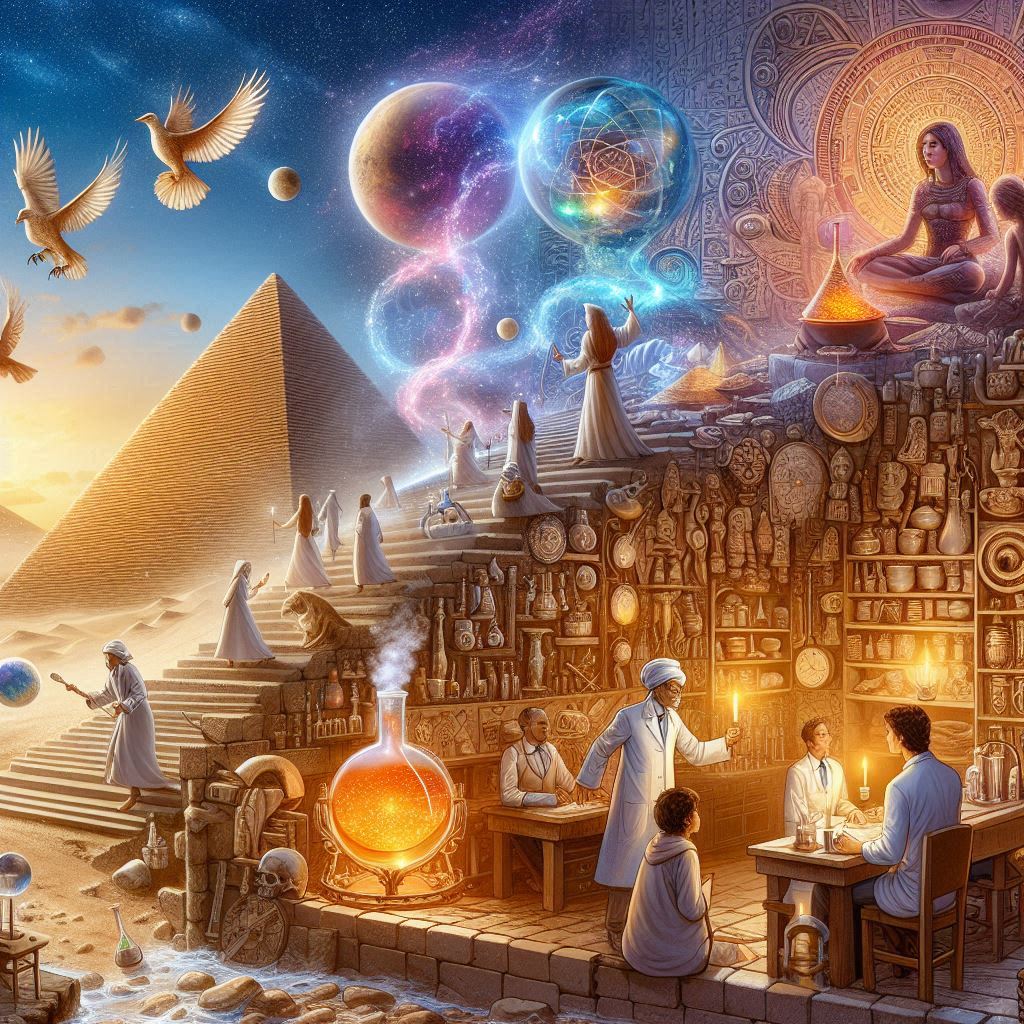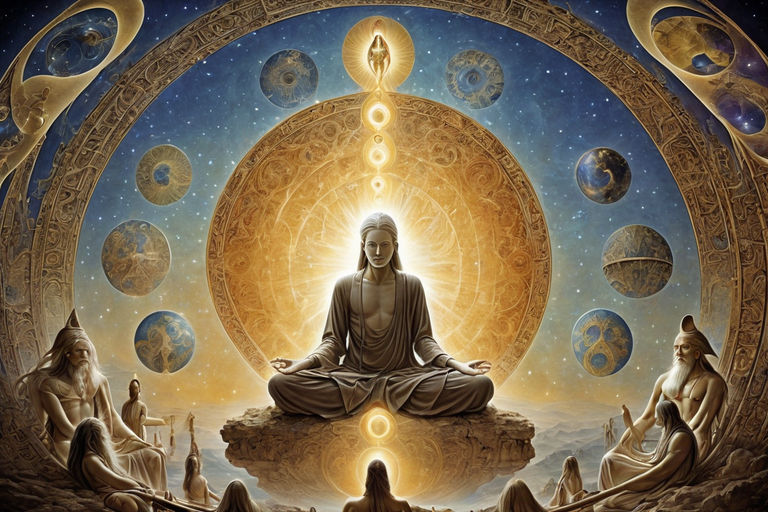From Ancient Mysticism to Modern Enlightenment:The New Age Journey
Unlock the secrets of the New Age movement with a fascinating journey from ancient mysticism to modern enlightenment. Don’t miss out!
Topics
- Early Influences
- Emergence of the New Age Movement
- New Age Beliefs and Practices
- Evolution of the New Age Movement
- Final Thoughts
Embracing spirituality and seeking enlightenment have long been innate desires of human beings throughout history. The New Age Movement, with its holistic approach to well-being and its emphasis on the interconnectedness of mind, body, and spirit, has provided a path for many individuals seeking a deeper understanding of themselves and the world around them. In this article, let’s embark on a journey tracing the roots and evolution of the New Age Movement, from its early influences to its modern manifestations.
The New Age Movement has origins steeped in a rich tapestry of religious, philosophical, and cultural currents that have evolved over centuries. Emerging prominently in the 1960s and 70s, its lineage can be traced back to earlier spiritual movements such as Theosophy and Eastern philosophies that began infiltrating Western thought during the late 19th century. Figures like Helena Blavatsky brought concepts of karma and reincarnation into popular discourse, paving the way for a more eclectic spiritual synthesis. As counterculture flowered amidst societal upheaval, seekers embraced holistic practices—combining astrology, meditation, crystals, and alternative healing—which became emblematic of this collective quest for personal transformation.
Interestingly, while often associated with individual spirituality today, the New Age Movement also reveals an underlying communal aspect rooted in shared consciousness. The transition from authoritative religious structures to personalized spirituality reflects broader societal shifts toward individualism characterized by postmodernity. Notably, technological advances facilitated the widespread sharing of these ideas; telecommunication venues like radio shows and later digital platforms allowed for an explosion of metaphysical knowledge beyond local communities. This evolution underscores a desire for enlightenment and a reaction against materialism—a yearning for greater meaning amidst modern chaos—painting the New Age as both a rebellion against tradition and a search for deeper existential truths woven through collective consciousness.
Early Influences
As we delve into the history of the New Age Movement, it becomes evident that its origins can be traced back to various mystical and philosophical traditions. Theosophy, a spiritual movement founded in the late 19th century, played a significant role in shaping the beliefs of the New Age Movement. Theosophists believed in hidden knowledge that could be accessed through intuition and spiritual practices, paving the way for exploring esoteric teachings.
Spiritualism, another influential precursor to the New Age Movement, gained popularity in the 19th century, focusing on communication with the spirit world through mediums. This fascination with the afterlife and the existence of unseen realms planted the seeds for the New Age Movement’s interest in channeling and spiritual communication.
Transcendentalism, a philosophical movement that emerged in the early 19th century in the United States, emphasized the inherent goodness of individuals and the importance of intuition and inner knowledge. The ideas of transcendentalists such as Ralph Waldo Emerson and Henry David Thoreau resonated with the core principles of the New Age Movement, paving the way for integrating Eastern spiritual practices and beliefs into Western spirituality.

Emergence of the New Age Movement
The 1960s counterculture movement played a pivotal role in the emergence of the New Age Movement. This movement rejected traditional societal norms and embraced alternative lifestyles and spiritual practices. This era witnessed a surge of interest in Eastern philosophies, meditation, and holistic healing, setting the stage for the New Age Movement to flourish.
As Eastern spiritual practices such as yoga, meditation, and Buddhism gained popularity in the West, they became integral components of the New Age Movement’s belief system. Blending Eastern and Western spiritual traditions allowed individuals to explore new avenues of self-discovery and personal growth.
New Age literature, including the works of authors like Helena Blavatsky, Edgar Cayce, and Alice Bailey, played a crucial role in disseminating the teachings and practices of the New Age Movement. These influential figures helped popularize concepts such as reincarnation, karma, and the interconnectedness of all living beings, shaping the foundational beliefs of the movement.
New Age Beliefs and Practices
One of the defining features of the New Age Movement is its holistic approach to healing and well-being. Energy healing, crystal therapy, and aromatherapy are commonly used to promote physical, emotional, and spiritual wellness. By addressing the root causes of imbalance and disease, these holistic modalities aim to restore harmony and vitality to the individual.
The New Age Movement also emphasizes the interconnectedness of mind, body, and spirit, recognizing that true healing occurs when all aspects of the self align. This holistic perspective encourages individuals to cultivate self-awareness, practice mindfulness, and nurture their spiritual growth in tandem with their physical and emotional well-being.
Channeling, a practice where individuals purportedly communicate with non-physical entities or higher consciousness, is another core aspect of the New Age Movement. As a medium for spiritual messages and guidance, channelers offer seekers a pathway to access higher wisdom and deepen their understanding of the universe.
Evolution of the New Age Movement
In recent years, the New Age Movement has evolved in response to technological advancements and changes in societal attitudes towards spirituality. The rise of social media and digital platforms has enabled individuals to connect with like-minded seekers, share spiritual insights, and access a wealth of resources for personal growth and transformation.
While the New Age Movement has garnered mainstream acceptance in some circles, it has also faced criticism and skepticism from skeptics and traditional religious institutions. Despite these challenges, the movement attracts individuals seeking alternative spirituality, healing, and personal development approaches.
Looking ahead, the New Age Movement is poised to continue evolving to meet spiritual seekers’ changing needs and desires in a rapidly changing world. By incorporating innovative practices, embracing diversity, and fostering community connections, the New Age Movement holds the potential to inspire more significant levels of self-awareness, compassion, and spiritual awakening.
The History of the New Age Movement: A Journey Through Time
The New Age movement, a sprawling tapestry of beliefs and practices, is often misunderstood as a recent phenomenon. However, its roots delve deep into history, intertwining with ancient philosophies, religious movements, and cultural shifts.
Let’s trace the evolution of the New Age movement from its ancient precursors to its modern manifestation.
Ancient Roots
While the term “New Age” is relatively recent, the concepts it embodies have existed for millennia.
- Eastern Philosophies: Ancient Indian religions like Hinduism and Buddhism offered profound insights into spirituality, meditation, and the interconnectedness of all things. These ideas would later influence Western thought and become foundational to the New Age.
- Western Esotericism: Traditions such as Hermeticism, Gnosticism, and Alchemy explored hidden knowledge and spiritual truths, laying the groundwork for later occult and New Age movements.
19th Century Foundations
In the 19th century, we witnessed a resurgence of interest in spirituality and the occult, paving the way for the New Age.
- Theosophy: Founded by Madame Blavatsky, Theosophy synthesized Eastern and Western philosophies, introducing concepts like reincarnation, karma, and esoteric wisdom.
- New Thought: This movement emphasized the power of positive thinking and the mind’s ability to heal the body. It laid the groundwork for the New Age focus on personal transformation and well-being.
- Spiritualism: The belief in communication with the dead gained popularity, fostering a fascination with the afterlife and spiritual realms.
The Counterculture and the Rise of the New Age
The 1960s counterculture provided fertile ground for the New Age movement.
- Rejection of Materialism: The counterculture’s emphasis on peace, love, and environmentalism resonated with New Age ideals.
- Exploration of Consciousness: Psychedelic experiences and interest in Eastern philosophies expanded consciousness and inspired a search for deeper meaning.
- Human Potential Movement: This movement focused on personal growth and self-discovery, aligning with New Age values.
The New Age in the Modern Era
The 1970s marked the official emergence of the New Age movement.
- Popularization of New Age Ideas: Books, magazines, and wellness centers introduced New Age concepts to a broader audience.
- Integration of Diverse Practices: The New Age movement incorporated many practices, from yoga and meditation to astrology and crystal healing.
- Consumer Culture and the New Age: The movement adapted to commercialization, with New Age products and services becoming mainstream.
The New Age movement is a dynamic and ever-evolving phenomenon. While its roots stretch back millennia, its contemporary form is a product of complex historical, cultural, and social factors. By understanding its history, we can gain a deeper appreciation for the movement’s diversity and its enduring appeal.
Final Thoughts
As we reflect on the rich tapestry of influences and developments that have shaped the New Age Movement, we gain a deeper appreciation for its enduring relevance and impact on contemporary spirituality. The journey through the movement’s history illuminates the interconnectedness of diverse spiritual traditions, the power of individual and collective transformation, and the timeless quest for enlightenment.
May this exploration of the New Age Movement inspire you to delve deeper into the mysteries of the universe, nurture your spiritual well-being, and embark on your journey of self-discovery and personal growth.





